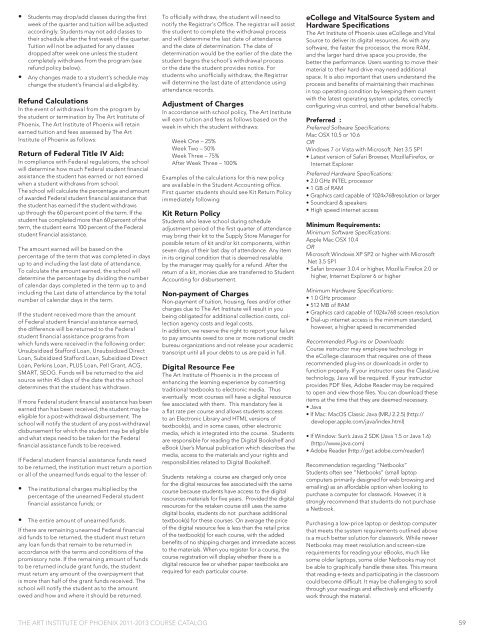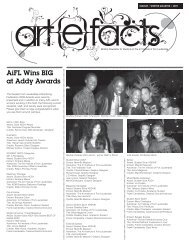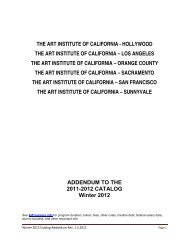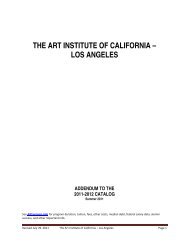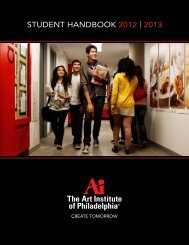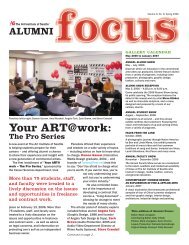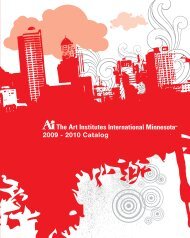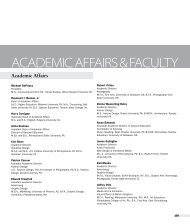2011-2013 CATALOG - The Art Institutes
2011-2013 CATALOG - The Art Institutes
2011-2013 CATALOG - The Art Institutes
You also want an ePaper? Increase the reach of your titles
YUMPU automatically turns print PDFs into web optimized ePapers that Google loves.
• Students may drop/add classes during the first<br />
week of the quarter and tuition will be adjusted<br />
accordingly. Students may not add classes to<br />
their schedule after the first week of the quarter.<br />
Tuition will not be adjusted for any classes<br />
dropped after week one unless the student<br />
completely withdraws from the program (see<br />
refund policy below).<br />
• Any changes made to a student’s schedule may<br />
change the student’s financial aid eligibility.<br />
Refund Calculations<br />
In the event of withdrawal from the program by<br />
the student or termination by <strong>The</strong> <strong>Art</strong> Institute of<br />
Phoenix, <strong>The</strong> <strong>Art</strong> Institute of Phoenix will retain<br />
earned tuition and fees assessed by <strong>The</strong> <strong>Art</strong><br />
Institute of Phoenix as follows:<br />
Return of Federal Title IV Aid:<br />
In compliance with Federal regulations, the school<br />
will determine how much Federal student financial<br />
assistance the student has earned or not earned<br />
when a student withdraws from school.<br />
<strong>The</strong> school will calculate the percentage and amount<br />
of awarded Federal student financial assistance that<br />
the student has earned if the student withdraws<br />
up through the 60 percent point of the term. If the<br />
student has completed more than 60 percent of the<br />
term, the student earns 100 percent of the Federal<br />
student financial assistance.<br />
<strong>The</strong> amount earned will be based on the<br />
percentage of the term that was completed in days<br />
up to and including the last date of attendance.<br />
To calculate the amount earned, the school will<br />
determine the percentage by dividing the number<br />
of calendar days completed in the term up to and<br />
including the Last date of attendance by the total<br />
number of calendar days in the term.<br />
If the student received more than the amount<br />
of Federal student financial assistance earned,<br />
the difference will be returned to the Federal<br />
student financial assistance programs from<br />
which funds were received in the following order:<br />
Unsubsidized Stafford Loan, Unsubsidized Direct<br />
Loan, Subsidized Stafford Loan, Subsidized Direct<br />
Loan, Perkins Loan, PLUS Loan, Pell Grant, ACG,<br />
SMART, SEOG. Funds will be returned to the aid<br />
source within 45 days of the date that the school<br />
determines that the student has withdrawn.<br />
If more Federal student financial assistance has been<br />
earned than has been received, the student may be<br />
eligible for a post-withdrawal disbursement. <strong>The</strong><br />
school will notify the student of any post-withdrawal<br />
disbursement for which the student may be eligible<br />
and what steps need to be taken for the Federal<br />
financial assistance funds to be received.<br />
If Federal student financial assistance funds need<br />
to be returned, the institution must return a portion<br />
or all of the unearned funds equal to the lesser of:<br />
• <strong>The</strong> institutional charges multiplied by the<br />
percentage of the unearned Federal student<br />
financial assistance funds; or<br />
• <strong>The</strong> entire amount of unearned funds.<br />
If there are remaining unearned Federal financial<br />
aid funds to be returned, the student must return<br />
any loan funds that remain to be returned in<br />
accordance with the terms and conditions of the<br />
promissory note. If the remaining amount of funds<br />
to be returned include grant funds, the student<br />
must return any amount of the overpayment that<br />
is more than half of the grant funds received. <strong>The</strong><br />
school will notify the student as to the amount<br />
owed and how and where it should be returned.<br />
To officially withdraw, the student will need to<br />
notify the Registrar’s Office. <strong>The</strong> registrar will assist<br />
the student to complete the withdrawal process<br />
and will determine the last date of attendance<br />
and the date of determination. <strong>The</strong> date of<br />
determination would be the earlier of the date the<br />
student begns the school’s withdrawal process<br />
or the date the student provides notice. For<br />
students who unofficially withdraw, the Registrar<br />
will determine the last date of attendance using<br />
attendance records.<br />
Adjustment of Charges<br />
In accordance with school policy, <strong>The</strong> <strong>Art</strong> Institute<br />
will earn tuition and fees as follows based on the<br />
week in which the student withdraws:<br />
Week One – 25%<br />
Week Two – 50%<br />
Week Three – 75%<br />
After Week Three – 100%<br />
Examples of the calculations for this new policy<br />
are available in the Student Accounting office.<br />
First quarter students should see Kit Return Policy<br />
immediately following<br />
Kit Return Policy<br />
Students who leave school during schedule<br />
adjustment period of the first quarter of attendance<br />
may bring their kit to the Supply Store Manager for<br />
possible return of kit and/or kit components, within<br />
seven days of their last day of attendance. Any item<br />
in its original condition that is deemed resalable<br />
by the manager may qualify for a refund. After the<br />
return of a kit, monies due are transferred to Student<br />
Accounting for disbursement.<br />
Non-payment of Charges<br />
Non-payment of tuition, housing, fees and/or other<br />
charges due to <strong>The</strong> <strong>Art</strong> Institute will result in you<br />
being obligated for additional collection costs, collection<br />
agency costs and legal costs.<br />
In addition, we reserve the right to report your failure<br />
to pay amounts owed to one or more national credit<br />
bureau organizations and not release your academic<br />
transcript until all your debts to us are paid in full.<br />
Digital Resource Fee<br />
<strong>The</strong> <strong>Art</strong> Institute of Phoenix is in the process of<br />
enhancing the learning experience by converting<br />
traditional textbooks to electronic media. Thus<br />
eventually most courses will have a digital resource<br />
fee associated with them. This mandatory fee is<br />
a flat rate per course and allows students access<br />
to an Electronic Library and HTML versions of<br />
textbook(s), and in some cases, other electronic<br />
media, which is integrated into the course. Students<br />
are responsible for reading the Digital Bookshelf and<br />
eBook User’s Manual publication which describes the<br />
media, access to the materials and your rights and<br />
responsibilities related to Digital Bookshelf.<br />
Students retaking a course are charged only once<br />
for the digital resources fee associated with the same<br />
course because students have access to the digital<br />
resources materials for five years. Provided the digital<br />
resources for the retaken course still uses the same<br />
digital books, students do not purchase additional<br />
textbook(s) for these courses. On average the price<br />
of the digital resource fee is less than the retail price<br />
of the textbook(s) for each course, with the added<br />
benefits of no shipping charges and immediate access<br />
to the materials. When you register for a course, the<br />
course registration will display whether there is a<br />
digital resource fee or whether paper textbooks are<br />
required for each particular course.<br />
eCollege and VitalSource System and<br />
Hardware Specifications<br />
<strong>The</strong> <strong>Art</strong> Institute of Phoenix uses eCollege and Vital<br />
Source to deliver its digital resources. As with any<br />
software, the faster the processor, the more RAM,<br />
and the larger hard drive space you provide, the<br />
better the performance. Users wanting to move their<br />
material to their hard drive may need additional<br />
space. It is also important that users understand the<br />
process and benefits of maintaining their machines<br />
in top operating condition by keeping them current<br />
with the latest operating system updates, correctly<br />
configuring virus control, and other beneficial habits.<br />
Preferred :<br />
Preferred Software Specifications:<br />
Mac OSX 10.5 or 10.6<br />
OR<br />
Windows 7 or Vista with Microsoft .Net 3.5 SP1<br />
• Latest version of Safari Browser, MozillaFirefox, or<br />
Internet Explorer<br />
Preferred Hardware Specifications:<br />
• 2.0 GHz INTEL processor<br />
• 1 GB of RAM<br />
• Graphics card capable of 1024x768resolution or larger<br />
• Soundcard & speakers<br />
• High speed internet access<br />
Minimum Requirements:<br />
Minimum Software Specifications:<br />
Apple Mac OSX 10.4<br />
OR<br />
Microsoft Windows XP SP2 or higher with Microsoft<br />
.Net 3.5 SP1<br />
• Safari browser 3.0.4 or higher, Mozilla Firefox 2.0 or<br />
higher, Internet Explorer 6 or higher<br />
Minimum Hardware Specifications:<br />
• 1.0 GHz processor<br />
• 512 MB of RAM<br />
• Graphics card capable of 1024x768 screen resolution<br />
• Dial-up internet access is the minimum standard,<br />
however, a higher speed is recommended<br />
Recommended Plug-ins or Downloads:<br />
Course instructor may employee technology in<br />
the eCollege classroom that requires one of these<br />
recommended plug-ins or downloads in order to<br />
function properly. If your instructor uses the ClassLive<br />
technology, Java will be required. If your instructor<br />
provides PDF files, Adobe Reader may be required<br />
to open and view those files. You can download these<br />
items at the time that they are deemed necessary.<br />
• Java<br />
• If Mac: MacOS Classic Java (MRJ 2.2.5) (http://<br />
developer.apple.com/java/index.html)<br />
• If Window: Sun’s Java 2 SDK (Java 1.5 or Java 1.6)<br />
(http://www.java.com)<br />
• Adobe Reader (http://get.adobe.com/reader/)<br />
Recommendation regarding “Netbooks”<br />
Students often see “Netbooks” (small laptop<br />
computers primarily designed for web browsing and<br />
emailing) as an affordable option when looking to<br />
purchase a computer for classwork. However, it is<br />
strongly recommend that students do not purchase<br />
a Netbook.<br />
Purchasing a low-price laptop or desktop computer<br />
that meets the system requirements outlined above<br />
is a much better solution for classwork. While newer<br />
Netbooks may meet resolution and screen-size<br />
requirements for reading your eBooks, much like<br />
some older laptops, some older Netbooks may not<br />
be able to graphically handle these sites. This means<br />
that reading e-texts and participating in the classroom<br />
could become difficult. It may be challenging to scroll<br />
through your readings and effectively and efficiently<br />
work through the material.<br />
THE ART INSTITUTE OF PHOENIX <strong>2011</strong>-<strong>2013</strong> COURSE <strong>CATALOG</strong> 59


